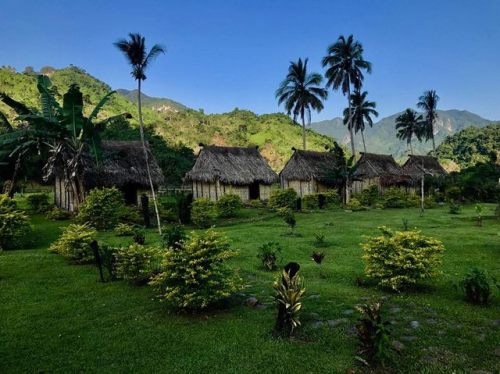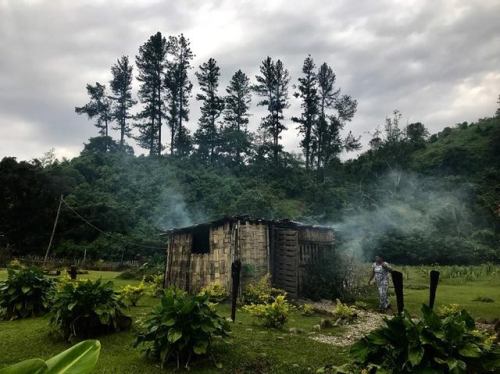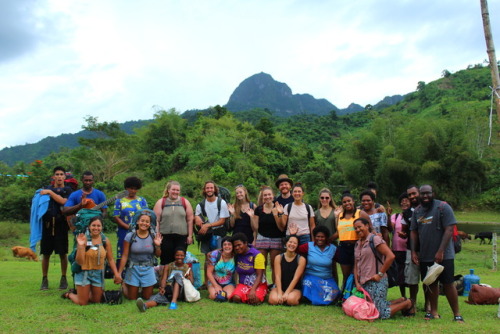#asia pacific
Culture and Ecology of the Fijian Islands
by Miranda Hope Shea
We touched down in Fiji amongst a riot of colors— rich greens and yellows splashed with pink and red blossoms. The air was heavy with rain, a light mist catching our hair and clothes as we stepped off the plane and walked down the tarmac to congregate by the luggage carousel. The people before me hugged and laughed, hoisting massive backpacks over their shoulders with eager determination. I smiled nervously. Being a transfer student is a strange mixture of nervousness and excitement. A new country with new courses and new faces: a challenge I was ready to take on. I lugged my own bag, packed with essential hiking and trekking gear, and clothes suited to the hot climates we would be travelling to, over to the group to be greeted with hearty welcomes and enthusiastic chatter about the adventures to come.
A band of excited students, we piled into vans that whisked us off to our apartments in Suva, the countries’ capital. Over the next week we would get to know each other, our professor, and our student coordinator while beginning our introduction to courses like Political Economy and Ecology, International Development, and the overreaching course of Global Studies III. We would take our first Innovative Encounters with Nature and Knowledge trip to Sigatoka; a town on the southern coast of the main island of Viti Levu, where we explored the ancient burial grounds of the Lupita people, jumped off massive sand dunes, and learned about the intersection of human and nature while planting trees for forest regrowth. In Suva we visited the Fiji Museum and began asking ourselves questions about colonization, and the process of its deconstruction. This would remain a theme throughout the semester, as we delved deeper into the subject, working on creating an understanding of the roles we played as tourists, as Global Studies Students, and as Westerners. We also were able to collaborate with Masters students studying at the University of the South Pacific, discussing climate change and it’s drastic effects on the nations of the region. This experience raised our sense of urgency, making us ask ourselves how we can each make an effort to combat global warming.
Namosi: an eco-resort tucked away in the lush highlands of the island. The way we got there? On the back of a truck, packed in like sardines, jolting over the gravelly and narrow mountain roads. “Bet you never thought this would be your classroom, huh?” my professor asked, computer perched precariously on his lap, typing away furiously mid-bus ride. I shook my head, laughing as he clung to the keyboard for dear life. We arrived in Namosi, a bit hot and dusty, only to ford a river with bags over our heads, to arrive at our destination. All in one piece, the weekend commenced with a bonfire, a kava ceremony, and a brilliant sky crowded with stars. Respecting local tradition was important for our group. One of our key learning goals was to immerse ourselves in a culture, learning from, rather than about. This meant adhering to local custom such as the wearing of sulus: a length of cloth wrapped about the waist (worn by both men and women) as we passed through villages on our way to a remote waterfall. We trekked through the mud, up steep inclines, and through low hanging palm fronds to emerge at the top of an icy cascade—a welcome relief at the end of the sweltering jungle. This would be one of many waterfalls we would see, a running joke amongst us students: “we might as well call this waterfall school!” But ultimately, it would be experiences like this that would cultivate a deep appreciation for the ecology of the South Pacific, and the struggles it faces.
We would learn further about this during our homestay within the community of Waitabu, on the Island of Tavuni where we would scale more waterfalls, hike in the warm rain along the beach, and make lasting connections with the locals. Our trip to the third largest Fijian island was a twenty-hour ferry ride, after which we gratefully clambered off the boat onto the aptly named “Garden Island”. We arrived at the community near dusk, the sky turning apricot and gold over the ocean before us. The people there welcomed us with open arms, every single one of us feeling at home immediately. The village is one that has had a massive impact on the way Marine Protected Areas are incorporated, using traditional concepts to deem “qoliqoli” (fishing areas) to be “tabu” (no-take zones). For ten years now the village has been an example of how the nexus of local laws and traditions and modern science can be incorporated to create environmentally sustainable areas. We were able to snorkel and dive here, and in the breathtaking Rainbow Reef where the explosion of life and color was unlike anything I had ever seen before. The aqua water, the salt on our skin, resting in the shade of coconut trees eating soursop and pineapple surrounded by flowers—it was an awe-inspiring experience. Yet the beauty of the people and their land is threatened by the encroaching threat of rising sea levels and natural disasters. What we were able to experience might not last for generations to come if greater action isn’t taken, on an international scale. Fiji opened our minds to the realities of these issues, while also finding a place in our hearts for years to come.
Post link
IPEF Will Be A Hard Sell In Indo-Pacific
IPEF Will Be A Hard Sell In Indo-Pacific
A new economic bloc comprising twelve countries of the Indo-Pacific region and the United States was unveiled on Monday in Tokyo on the sidelines of President Joe Biden’s visit. Christened as the Indo-Pacific Economic Framework (IPEF), it is conceived as the economic correlative of the US Indo-Pacific Strategy.
The Biden Administration expects that the IPEF will serve as an important tool of the…

Broga® Yoga is on a Ramadan Break!

Hey peeps! I know this is a lil late, but just a heads up that Broga® Yoga is on a break during Ramadan!
Broga Yoga at Activ StudiofromDan YogaFitonVimeo.
We had an awesome time during April (check out the video above!), and are excited to have to after Raya! See you then!
If you would like to learn more about Broga®, contact me here!
Updated Yoga Class Schedule – Feb 2019

Here’s an updated schedule for the first quarter of 2019 (I mean, the first quarter in Malaysia always starts after Chinese New Year, right? Ha ha! ).
I am excited that I have a new class at Aravind Yoga, 7 pm on Wednesdays, beginning 13 Feb 2019! Hope to catch you there!
Tuesday:
- 0915 Yoga, Anytime Fitness 8 Kinrara, Puchong (60 mins)
- 1900Broga® Yoga,Activ Studio (60 mins)
Wednesday:
- 1900…

I’m so thrilled to be hosting my first “Yoga, Emotions & Essential Oils” session at dōTERRA Malaysia’s office. For awhile now, I have been interested in mood management, stress management and also trauma sensitive yoga. I began this journey helping an NGO teach yoga to girls from troubled homes, and then fitness and eventually yoga to human trafficked children. But I figured that people in…

Cobra pose with props from the first day
One of the best things about Manasa Yoga School is the philosophy taught in every class and workshop. Manoj Khaimalis on a quest to get us, his students, to move from the doing to discerning enquiry, from the form to formlessness. In fact, it was his Natarajasana workshop in 2011 that made me decide to do my yoga teacher training with him. The denouement…

The past three years, I have been teaching a 77-year old ex-air force man some yoga. Uncle (let’s call him that coz I do) is a man who is active, not just physically but also mentally. He teaches himself (with online help) some Sanskrit and some Indian mathematics. He also taught himself yoga. This alarmed his daughter who got me to go in to teach him personally. Wise move!
[vimeo 299371269 w=640…
Getaways for the Snorkeling Set: Luxury Homes in Bali, Tahiti and Australia
Water lovers around the world are heading to resort areas in the Asia-Pacific for an amphibious lifestyle: buying luxury homes near surfing, snorkeling, deep-sea fishing and other world-class water sports.
Post link
Semi-Annual Jamberry Inventory Sale!
It’s That Special Time of Year!Two times a year I offer certain items in my inventory for sale.
Please join my Inventory Vault on Facebook to take a look!
Items include wraps (all Markets), lacquers, gels and hand care products (US Only).Whether it’s your first time to use Jamberry or you are a long time user, this is a great time to stock up on your favorites!

US soldiers bathing and washing clothes during a lull in the fighting on Saipan. June 1944. Photograph by Peter Stackpole.














